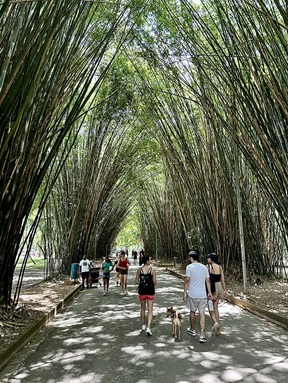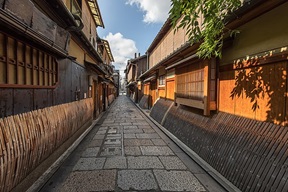Material District recently renewed its publication on bamboo. ‘Booming bamboo, the (re)discovery of a sustainable material with endless possibilities’, is a stunning book written by Pablo van der Lugt; with indeed: endless applications. As Elora Hardy notes in her foreword: ‘We are just beginning to explore bamboo’s extraordinary range. Bamboo is full of character, integrity and individuality, far beyond a simple wood replacement. Bamboo is simply the most elegant, efficient, replenishable material around.’

Transition to a biobased economy
The buildup of the book is almost academic. In starts with the transition to a biobased economy and the way bamboo fits into that movement. Only in chapter 5, we delve into ‘bamboo technology’. A remarkable chapter, with many applications. It also shows that many uses have been developed rather recently; and that this movement is still going on.
But let’s follow the argument of the book. In chapter 1, we look into the ‘transition to a biobased economy’. ‘Because of the growing global population, overconsumption and a take-make-waste economy, we are heading towards a potentially irreversible resource and climate problem.’ We are in need for an important role for renewable, biobased materials. At present, we extract too many resources, we emit too much CO2. The bult environment is an important player in this process; certainly in view of the fact that experts expect a massive 60% growth of this sector in the next 30 years. We need to transition to a circular and biobased economy.
A special crop
Bamboo is a special crop. It is, in fact, a giant species of grass. It is very strong, almost as strong and stiff as steel. There exist over 1,600 species of bamboo. It doesn’t grow in width, the sprouts are wide already. It doesn’t die after harvesting, because the roots stay alive. It is hardly susceptible to clearcutting and therefore prevents deforestation. It can be used for rehabilitation of degraded land, improving soil quality and restoring the water table.
Traditionally, bamboo has been regarded as an inferior construction material. But in recent times, this changed. The 1984 publication ‘The book of bamboo’ by David Farrely provided 1546 different applications of bamboo. Since then, this number grew explosively. Bamboo can be used for aircraft cladding, beer extracts, edible shoots and gramophone needles, scaffolding, paper, medicines and flooring. Recently, industrial pressing of bamboo strips and fibers has multiplied the number of applications. Bamboo is a flexible material; it doesn’t deplete the soil; and due to its fast growth, it often captures much CO2.

Construction materials
The material can be worked into many applications. China is by far the leading country in bamboo technology, but other countries like Mexico, Vietnam and Canada grow fast. Bamboo can be flattened using vapor treatment; used for lamination of strips, producing panels, beams and flooring boards; or compressed with a resin to boards and panels, both for inside and outside use.
Using bamboo as a construction material would constitute an important way of preventing carbon dioxide emissions. One important strategy here is to plant bamboo on degraded land. This will restore the land while at the same time capturing carbon dioxide. Particularly if the crop is being harvested on an annual basis. In doing so, a well-managed bamboo plantation can produce a constant feedstock of material each year. It will regrow quickly without the need to replant. This harvest will substitute abiotic materials such as concrete or plastic, each with their specific emissions. On the other hand, if a patch of bamboo forest isn’t harvested, it’s productivity and carbon sequestering will fall dramatically.
Bamboo applications
Then in the book we find the most interesting chapter 5, where applications of bamboo materials are discussed. In it’s countries of origin, bamboo is extensively used for construction purposes. In Western countries this is much less so; among others because of a lack of building codes and the irregularity of the material. There, temporary constructions predominate; whereas in bamboo-growing countries, it has a far higher potential for mass application in the building industry.
Bamboo can be bent by local heating. It can be cut, either perpendicularly, diagonally or longitudinally and yield surprising results. It can be flattened to flooring boards by vapor treatment. It can be manufactured into strips, and these strips can then be glued together and used as beams, flooring planks or thin veneer sheets. Bamboo can also be used for the production of beams. First, bundles are crushed and glued together, then submerged in a resin. Depending on the starting material and the process, this may produce strong beams, either for outside or inside use. And then, we can also process bundles into composite materials, where light weight, form freedom and strength are key attributes. This is a relatively new area that is still in development.
And there are even more applications. One of them is the production of so-called slivers (thin strips). Used in woven bamboo, coiled (pressed) bamboo, and mats. Small items (chips) can still be processed: to fibre board and particle board, and finally to paper and textile. In short, the applications are endless and some are still in development.
Towards a biobased economy
Chapter 6 starts out with the insight that we need to make a radical move towards a biobased economy, in order to stay within the world’s carbon budget. Bamboo can help us doing so. Not just in the applications mentioned so far, but also in hybrid composites; and in various industries like the automotive, aviation, infrastructure and wind turbine blade industries.
The industry will still have to develop thoughtful and climate effective applications. Not just the source of supply needs to be sustainable – we also need a suitable infrastructure for treatment and transport; and supportive suppliers and legislation. Processes and additives will have to be clear. Any chemicals used need to be scrutinized.
Applications
And then, finally in chapter 7, we meet designs in bamboo. A wonderful collection of forms. Bamboo was used in the construction of an international airport terminal in India. In a cathedral-like building, and in a fantasy home in Bali, Indonesia. In prefabricated homes in Utah in the United States. In a pavilion in Venice. For construction of a private home in Gent, Belgium. In a pavilion in Taiwan. In a lodge across a lake in China. In a carport in Johannesburg. In a secondary school in Chiang Mai, Thailand. And in many more applications. This is a stunning book, that convinces through its width, depth and the number and scope of the applications shown.
The book Booming bamboo is for sale at € 33,50 at Material District.
Interesting? Then also read:
Bamboo, a promising feedstock
New biobased materials
Affordable green homes
